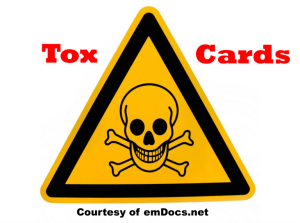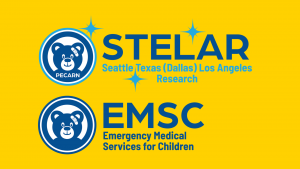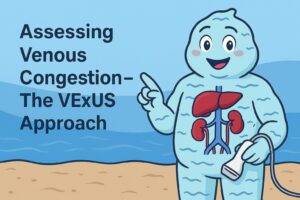Original podcast posted on PEM Currents – Hosted by Brad Sobolewski (@PEMTweets) and co-authored by Dennis Ren (@DennisRenMD)
This podcast series by PEM Currents is a co-production with the Emergency Medical Services for Children Innovation and Improvement Center (EMSC IIC), whose mission is to minimize morbidity and mortality of acutely ill and injured children across the emergency continuum.
The emDOCs.net team is very happy to collaborate with PEM Currents and EMSC IIC to further disseminate this 5-part podcast series focusing on agitation in children and adolescents.
Podcast: Play in new window | Download (Duration: 22:31 — 30.9MB)
Subscribe: Apple Podcasts | Google Podcasts | RSS
Differentiating Organic versus Psychiatric
Learning Objectives:
- Describe the findings on history and physical examination that differentiate organic vs psychiatric causes of agitation and AMS.
- Develop a strategy to differentiate organic from psychiatric causes of AMS, including using ancillary studies.
Frankly this issue of organic or psychiatric has actually long been derided. In fact Wilson (that Dr. Wilson, the copper disease guy) said that the functional-organic distinction “lingers at the bedside and in medical literature, though it is transparently false and has been abandoned long since by all contemplative minds” – this was in the textbook Neurology, in the 1940s. And yet this distinction persists in medical education, even in podcasts. So it is with that that I acknowledge that this somewhat artificial distinction between psychiatry and neurology is a bit of a naïve discrimination that may encourage the continued stigmatization of mental health problems. So think of this episode less about “is it psych or not” and more about not missing something because you assumed the patient had a mental or behavioral problem.
So, figuring out if it is something medical or psychiatric in instances of acute agitation and AMS is different than “medical clearance” for many mental health visits. I still think it is a useful exercise in sharpening your diagnostic skills.
Definitions:
- Psychosis – Disruption in thinking, accompanied by delusions or hallucinations
- Delusions – False, fixed beliefs that cannot be resolved through logical argument
- Hallucinations – False perceptions that have no basis in external stimuli
- Delirium – Altered sensorium, with waxing and waning deficits in attention and concentration. Orientation and concentration are preserved in functional psychosis.
- Agitation – Feeling of irritability or restlessness
History
- It is important to get a history from both the patient and caregiver if possible because the information can be different.
- Ask both parties about why they believe they are presenting to the emergency department.
- Sometimes we can identify triggers for these episodes (environment, personal), sometimes the behaviors have gradually escalated to the point where the caregiver becomes fearful for their own safety, the safety of the patient, or safety of other family members.
- Ask about suicidal ideation, homicidal ideation, audio or visual hallucinations
- Past medical history (autism, developmental delay, sensory processing disorder, psychiatric condition) and prior engagement with the mental health system is important to ascertain
- A family history of psychiatric disease or longstanding bizarre behaviors supporting a diagnosis of a psychiatric disease (still – developing a psychotic disorder before the age of 12 is rare, in this population medical >>>psych ). Unless there is a past history of the exact same behavior or an existing psychiatric diagnosis it is dangerous to assume that the cause of true altered mental status is psych.
- Acute onset AMS more common in medical causes, where you need to take an accurate history of when the behaviors changed, and the rate of change, when were they last normal, and if this has ever happened before and if so what was the context.
- History suggesting drug use or exposure (teen coming form music festival, abrupt change in toddler behavior, and suspected ingestion)
- This is where knowing common toxidromes is helpful
- Sympathomimetic – ie diphenhydramine ingestion, synthetic cannabinoids, jimson weed, etc.
- This is where knowing common toxidromes is helpful
- You may also see Tox from current medications (eg, corticosteroids, AEDs, atypical antipsychotics, isoniazid, amoxicillin, clarithromycin, and erythromycin have rarely caused neuropsychiatric symptoms including anxiety and hallucinations. )
- Constitutional symptoms (fevers, chills, headache) indicating an infectious etiology (meningitis, encephalitis)
- Rheum/inflammatory disease history – SLE
- Head trauma (intracranial injury)
- New onset of neurologic deficits (stroke, brain abscess, brain tumor)
- Seizure disorder or signs suggestive of seizure disorder (inattentiveness, rhythmic blinking or other stereotyped movements)
- Prior episodes associated with possible precipitating factors (eg, menstruation, medications, stress), vomiting, or headache suggestive of metabolic disease (urea cycle defects, acute intermittent porphyria [AIP]).
Physical examination
Before detailed exam make sure vitals are normal (brain getting enough oxygen, fever) and that the patient doesn’t have signs of hypoglycemia (altered mental status, diaphoresis, tachycardia, hypotension) – you need to fix those first.
Mental status
Patient with psychiatric illness typically has normal vital signs; normal orientation to person, place, and time; and intact memory with good cognitive functioning. Hallucinations are usually auditory in nature.
Medical psychosis usually abnormal vital signs, altered mental status, and impaired orientation with compromised intellectual function. Visual and tactile hallucinations are more classically “organic.” Note that brief hallucinations can occur in “normal” situations like:
- Falling asleep and waking
- Bereavement
- Sleep deprivation
- Caffeine
The Neurologic exam MUST be normal. Any abnormal neurologic exam finding is medical until proven otherwise.
The pupil exam is particularly “testable” and is often helpful:
- Conditions affecting the brain diffusely spare pupils – except for opiates.
- Miosis
- Cholinergics, Clonidine
- Opiates, Organophosphates
- Phenothiazines, Pilocarpine
- Sedative-hypnotics
- Mydriasis
- Antihistamines
- Antidepressants
- Anticholinergics (includes Atropine)
- Sympathomimetics
- Unilateral enlargement >5 mm + coma is herniation until proven otherwise
- Nystagmus can be seen in ketamine ingestions
Now I’ve noted a sea change with regard to how we address patients with functional symptoms. I can recall many times early in my career that I heard “oh, he’s just faking.”
- Catatonic patients preserve ability to maintain posture
- Patients with functional neurologic problems generally…
- Avoid hitting their face with a falling arm
- Resist eyelid opening
- Raise HR to auditory or painful stimuli (smelling salts)
- Intact DTR, oculovestibular, and oculocephalic reflexes
Fortunately in my experience a thorough clinician is able to figure out if something is “off” and initiate a workup in many instances. You should tailor your workup towards the findings and your index of suspicion. Reading the differential diagnosis would double the length of this episode – so I won’t do that. However big categories include as alluded to earlier:
- Toxindromes that present with agitation include anticholinergics, sympathomimetics, and hallucinogens (LSD), and marijuana
- CNS – mass, intracranial injury, stroke, seizure (post ictal psychosis, temporal lobe epilepsy), meningoencephalitis , and even subacute sclerosing panencephalitis which occurs with a measles infection (vaccinate people!)
- Infectious
- Lupus encephalitis will have auditory and tactile hallucinations (see – organic!)
- Metabolic Diseases
- Urea cycle defects – recurrent episodes of bizarre behavior, hallucinations, or delusions during adolescence and adulthood. Typically complain of headache and vomiting. Delayed presentation is most common with partial ornithine transcarbamylase deficiency. Interestingly these patients eat veggies because lots of protein causes headaches.
- Acute intermittent porphyria (AIP) leads to psychiatric complaints and psychosis (hysteria, anxiety, apathy, depression, phobias, psychosis, organic disorders, agitation, delirium, and altered consciousness) – drugs that induce the P450 microsomal oxidase system (eg, barbiturates), fasting, intercurrent illness, and premenstrual hormonal changes in women
- Wilson disease is the copper one that presents during adolescence with subacute psychiatric symptoms from depression to frank psychosis (catatonia and paranoia). Labs will show low ceruloplasmin concentrations and elevated urinary copper excretion. Oh yeah, something something. Kayser-Fleischer rings. It is potentially reversible.
- Uremia and hepatic encephalopathy cause AMS changes with hallucinations.
- There are MANY others!
- Postpartum psychosis: Seen up to 30 days after childbirth, and has paranoia, delusions, and hallucinations
- Electrolyte Derangements:
- Hyponatremia or hypernatremia behavior changes and encephalopathy that may be difficult to distinguish from acute psychosis.
- Hypocalcemia and hypomagnesemia may rarely cause frank psychosis.
- Hashimoto encephalopathy: Rare thyroid psychosis not often seen in children. Thyroid storm will see psychotic symptoms along with HIGH fever and autonomic symptoms.
Psychiatric causes of acute agitation include depression, bipolar disorder, childhood-onset schizophrenia, and brief reactive psychosis. Again, a history of mental illness in the family, emotional trauma, subacute to chronic symptoms, and coexistent mood disorder suggests a primary psychiatric disorder.
Management
In the patient with acute agitation start with ABCs, vital signs, IV access, and glucose. If they are a danger to themselves and the team, protecting their airway, and not in cardiorespiratory failure, try non-pharmacologic means first, but note that medical management may be necessary to keep them safe. If they have no prior mental health history, consider BZD (more on that in the upcoming medical management episode #3).
Ventilation may be impaired by declining respiratory drive or muscle dysfunction. Remember hypoxia cause AGITATION, and hypercarbia leads to SOMNOLENCE. Keep your goal O2 sat >95% and use ETCO2 to ensure ventilation. Intubate those who cannot sustain adequate oxygenation or ventilation. Don’t delay that decision!
Any concern for opiate intoxication should follow with a dose of IV or IN Narcan:
- Other antidotes are less widely used: Don’t give flumazenil for benzodiazepine OD as this can precipitate seizures and then you can’t treat them.
- Physostigmine may transiently improve MS in anticholinergic ingestion but you should call a medical toxicologist first.
- Diphenhydramine for dystonia can make a patient agitated.
Labs should ideally be based on concerning findings on H&P, but always ask yourself the following:
- Will the result alter the approach to treatment?
- Will it return in time to affect therapy positively?
Blood and urine tests to consider:
- iSTAT (rapid blood gas) +/- Accucheck
- Renal panel
- CBC and blood culture if febrile or infection suspected
- Tox – Acetaminophen, Salicylate, Ethanol, Urine Drug Screen
- ßhCG in all patients with female reproductive organs
- TSH with reflex to free T4
- Ammonia
Tox levels are routinely sent, but less helpful than we hope:
- APAP: Ingestions are usually symptomatic by 4-6 hours. Per Sporer et al Am J Emerg Med 1996 in a retrospective review of 1820 patients with SI or AMS with suspected ingestion, 0.3% had toxic APAP levels not suggested by history, none required NAC. In Chan et al Hum Exp Toxicol 1995, in a retrospective review of 294 Chinese patients, 4/208 with suspected APAP poisoning had elevated but non-toxic levels.
- Bottom line- In the absence of history however, still get one. If elevated then repeat at 4 hours
- ASA: Obtain in the unknown ingestion with AMS. Done nomogram no longer routinely used. Levels > 90-100 mg/dL are usually associated with severe toxicity. May need multiple determinations in massive ingestions or sustained release preparations.
- Alcohol (ETOH): Elimination follows zero order kinetics. Rate varies 12-25 mg/dL/h – naive drinkers 10 mg/dL/h. Rough correlation between level and symptoms. Level <300 mg/dL in a comatose patient should prompt search for another cause
- UDS Urine metabolites can be seen for 2-3 days, while blood 6-12 hours.
- Does a toxicology screen affect the management of a patient who has taken overdose? The cumulative evidence suggests not. Even if positive it rarely alters management. Plus not everything is detected on UDS. You need to know what is screen for and not screened for the sake of your local institution
Other than labs we often obtain EKGs, which is most helpful in suspected ingestions. Diagnostic for serious TCA overdose with QRS widening (≥0.10 sec) & rightward shift of the terminal 40 ms of the frontal plane QRS complex vector (terminal R wave in aVR)
LP with CSF Studies: If you suspect meningitis/encephalitis – are they Stable enough? Is sedation necessary and safe? If the patient is NOT septic, you can defer antibiotics until after CSF studies. Antibiotics to consider are ceftriaxone (meningitis dosing), vancomycin, and acyclovir (remember that HSV can cause temporal lobe encephalitis and behavior changes).
CT Head: Consider in elevated ICP, trauma, CSF shunt, focal neuro findings, and unsupervised child. May need to be a prelude to any LP if you suspect these
Now, with all of this discussion on workup I cannot ignore the face that MOST patients don’t need any studies to establish that they are “medically cleared.” Choosing Wisely released their recommendations for Pediatric Emergency Medicine recently and I’m going to quote their recommendations verbatim here – “Most children with acute mental health issues do not have underlying medical etiologies for these symptoms. A large body of evidence, in both adults and children, has shown that routine laboratory testing without clinical indication is unnecessary and adds to health care costs. Any diagnostic testing should be based on a thorough history and physical examination. Universal requirements for routine testing should be abandoned.”
Summary
OK, so that’s it for episode 1 of the Agitation podcast series. Today we reviewed the organic versus psychiatric divide, where we discussed how a thorough H&P guides any evaluation we perform. In the second episode we will discuss non-pharmacologic management of agitated children, which is the first steps in keeping them calm and safe.
Resources
- emDOCs.net Articles
- PEM Blog via Brad Sobolewski (@PEMTweets)
- EMSC IIC (Emergency Medical Services for Children Innovation and Improvement Center)
- EMSC IIC: Pediatric Education and Advocacy Kit (PEAK): Agitation
- For more info, please email km@emscimprovement.center or follow on Twitter @EMSCImprovement
Other Episodes in the Agitation Series
Episode 2: Non-pharmacologic management of agitated children (Coming May 24, 2023)
Episode 3: Pharmacologic management of agitated children (Coming May 31, 2023)
Episode 4: Safe pre-hospital transport of the agitated child (Coming June 7, 2023)
Episode 5: Management of the child with mental health problems who is boarded in the Emergency Department (Coming June 14, 2023)
References
Hua LL, COMMITTEE ON ADOLESCENCE. Collaborative Care in the Identification and Management of Psychosis in Adolescents and Young Adults. Pediatrics 2021; 147.
Sedel F, Baumann N, Turpin JC, et al. Psychiatric manifestations revealing inborn errors of metabolism in adolescents and adults. J Inherit Metab Dis 2007; 30:631.
Chun TH, Sargent J, Hodas GR. Psychiatric emergencies. In: Textbook of Pediatric Emergency Medicine, 5th, Fleisher GR, Ludwig S, Henretig FM (Eds), Lippincott Williams & Wilkins, Philadelphia 2006. P.1820.
Cunqueiro A, Durango A, Fein DM, et al. Diagnostic yield of head CT in pediatric emergency department patients with acute psychosis or hallucinations. Pediatr Radiol 2019; 49:240.
Gerson R, Malas N, Feuer V, Silver GH, Prasad R, Mroczkowski MM. Best Practices for Evaluation and Treatment of Agitated Children and Adolescents (BETA) in the Emergency Department: Consensus Statement of the American Association for Emergency Psychiatry. West J Emerg Med. 2019 Mar;20(2):409-418. doi: 10.5811/westjem.2019.1.41344. Epub 2019 Feb 19. Erratum in: West J Emerg Med. 2019 May;20(3):537. Erratum in: West J Emerg Med. 2019 Jul;20(4):688-689. PMID: 30881565; PMCID: PMC6404720.











4 thoughts on “PEM Currents – Agitation in Children – Episode 1: Differentiating Organic vs Psychiatric”
Pingback: Agitation Episode 2: Non-pharmacologic management – PEM Currents: The Pediatric Emergency Medicine Podcast
Pingback: Agitation Episode 3: Pharmacologic management – PEM Currents: The Pediatric Emergency Medicine Podcast
Pingback: Agitation Episode 4: Safe prehospital transport – PEM Currents: The Pediatric Emergency Medicine Podcast
Pingback: Agitation Episode 5: The boarded ED patient – PEM Currents: The Pediatric Emergency Medicine Podcast